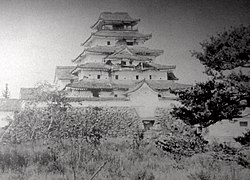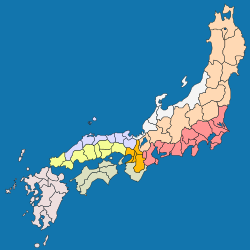Tōhoku region
The Tōhoku region (東北地方, Tōhoku-chihō) is one of Japan's traditional regions.[1] The Japanese conventions of geography and history divide the nation into eight regions, including the Tōhoku region.[2] These have been used since 1905 as basic units for description and comparison[3] and as cultural markers.
The regions of Japan are a fusion of historical divisions and modern administrative needs.[4] The significance of the region in Japan is geographical, cultural and administrative.[5]
History
In the late 7th century, the Tōsandō region were identified as one of the eight largest administrative areas of the Imperial system (ritsuryo seido).
Gokishichidō is an ancient system of names for parts of the country, including Tōsandō.[6] Tōhoku covers the northern area of the island of Honshū[7] in roughly the same area as the traditional Tōsandō.
In the Meiji period, the modern regional system was made by Imperial decree. Japan was divided into regions (chihō Archived 2017-03-24 at the Wayback Machine), including the Tōhoku region. A regional council (chihō gyōsei kyōgisai) was headed by the governor of the most powerful prefecture in the regional grouping. The council also included regional chiefs of central government ministries.[8]
Over time, Tōhoku has developed its own regional dialects, customs and unique traditional culture. Tōhoku is famous for farming. Now a lot of kinds of vegetable are grown.[9]
The Tohoku University was built in 1907.
In 2011, Tōhoku was struck with a very strong earthquake and tsunami. It caused a lot of damage. Now, people in Japan do their best for the complete revival of Tōhoku.
Geography
The region occupies the northeastern part of Honshu, which is the largest Japanese island.
Tōhoku Prefectures
The region has six prefectures. From north to south, they are:
Tōhoku Region Media
Aizuwakamatsu Castle after the Battle of Aizu, 1868 photograph
Related pages
References
- ↑ Nussbaum, Louis-Frédéric. (2005). "Geography" in Japan Encyclopedia, p. 242; "Tōhoku" in Japan Encyclopedia, p. 970.
- ↑ Library of Congress Country Studies, Japan (LOC), "Geographic Regions"; "The islands of Hokkaido, Shikoku, and Kyushu each form a region, and the main island of Honshu is divided into five regions"; retrieved 2012-4-15.
- ↑ Tames, Richard. (2008). A traveller's history of Japan, p. 264.
- ↑ Japan Ministry of Foreign Affairs (MOFA), "Regions of Japan"; retrieved 2012-4-15.
- ↑ Brandt, Kim. Kingdom of Beauty: Mingei and the Politics of Folk Art in Imperial Japan, pp. 218-219;Shapira, Philip et al. (1994). Planning For Cities And Regions In Japan, p. 193, citing Research Institute of Construction and Economy. (1991). "Fig. 2-7. "Regional Vitalization and Construction Administration," White Paper on Construction; retrieved 2012-8-28.
- ↑ Nussbaum, "Goki-shichidō" at p. 255.
- ↑ LOC, "Kinki"; retrieved 2012-4-15.
- ↑ Steiner, Kurt. (1965). Local Government in Japan, p. 62.
- ↑ Web-Japan.org, "Regions of Japan"; retrieved 2012-4-15.
- ↑ Nussbaum, Louis-Frédéric. (2005). "Tōhoku" in Japan Encyclopedia, p. 970.
Other websites
| Wikimedia Commons has media related to Lua error in Module:Commons_link at line 62: attempt to index field 'wikibase' (a nil value).. |
Coordinates: 38°54′N 140°41′E / 38.900°N 140.683°E








